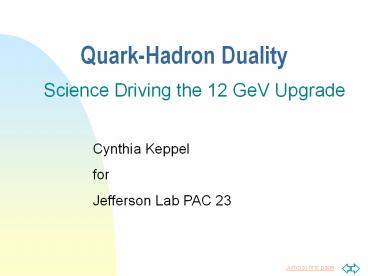Quark-Hadron Duality - PowerPoint PPT Presentation
Title:
Quark-Hadron Duality
Description:
Jump to first page. Quark-Hadron Duality. Science Driving the 12 GeV Upgrade. Cynthia Keppel ... between quarks at large distances equivalent to 10 tons, no ... – PowerPoint PPT presentation
Number of Views:29
Avg rating:3.0/5.0
Title: Quark-Hadron Duality
1
Quark-Hadron Duality
- Science Driving the 12 GeV Upgrade
Cynthia Keppel for Jefferson Lab PAC 23
2
QCD and the Strong Nuclear ForceQCD has the
most bizarre properties of all the forces in
nature
- Asymptotic freedom
- quarks feel almost no strong force when close
together - Confinement
- restoring force between quarks at large distances
equivalent to 10 tons, no matter how far apart
- QCD in principle describes all of nuclear physics
- at all distance scales - but how does it work?
3
Quark-Hadron Dualitycomplementarity between
quark and hadron descriptions of observables
At high enough energy
- Hadronic Cross Sections
- averaged over appropriate energy range
- Shadrons
- Perturbative
- Quark-Gluon Theory
Squarks
Can use either set of complete basis states to
describe physical phenomena
4
Example ee- hadronslim s(ee-
X) NC S eq2 E ? s(ee-
mm-) q
5
- At high energies interactions between quarks and
gluons become weak - (asymptotic freedom)
- efficient description of phenomena afforded in
terms of quarks - At low energies effects of confinement make
strongly-coupled QCD highly non-perturbative - collective degrees of freedom (mesons and
baryons) more efficient - Duality between quark and hadron descriptions
- reflects relationship between confinement and
asymptotic freedom - intimately related to nature and transition from
non-perturbative to perturbative QCD
Duality defines the transition from soft to hard
QCD.
6
Deep Inelastic Scattering ds ?
sMott S ei2xqi(x,Q2) qi(x,Q2)dWdE
- Bjorken Limit Q2, n ? ?
- Empirically, DIS region is where logarithmic
scaling is observed Q2 gt 5 GeV2, W2 gt 4 GeV2 - Duality Averaged over W, logarithmic scaling
observed to work also for Q2 gt 0.5 GeV2, W2 lt 4
GeV2, resonance regime
7
Observed for all unpolarized structure functions
8
Quark-hadron duality in nuclei
- If we had used only scintillators, scaling would
be thought to hold down to low Q2!
9
Duality in QCD
- Moments of the Structure Function
- Mn(Q2) S dx xn-2F(x,Q2)
- If n 2, this is the Bloom-Gilman duality
integral. - Operator Product Expansion
- Mn(Q2) ? (nM02/ Q2)k-1 Bnk(Q2)
- higher twist logarithmic dependence
- Duality is described in the Operator Product
Expansion as higher twist effects being small or
cancelling DeRujula, Georgi, Politzer
(1977) - Duality violations are not easily interpretable
by lattice QCD calculations!
1
0
?
k1
10
Separated Unpolarized Structure Functions at 11
GeV
Hall C
x 0.8
De gt 0.3
SHMS
HMS
Also necessary for polarized structure function
measurements...
11
Polarized Structure Functions at 11 GeV
Hall C
12
Neutron Structure Functions at 11 GeV
to CLAS
BONUS
D
e,
n
p
to recoil detector
e
- Detect 60-100 MeV/c
- spectator protons at large angles
- Map large region in Bjorken x
- and Q2 (up to 10 GeV2)
- 1st time rigorous p n moments!
- Proton-Neutron difference is acid
- test of quark-hadron duality
(7.5 atm thin deuterium target, radial TPC, DVCS
solenoid)
13
Applications of Quark-Hadron Duality
- Allows for direct comparison to QCD Moments
- CTEQ currently considering the use of duality for
large x parton distribution modeling - Neutrino community planning to test duality
- Neutrino community using duality to predict low
energy (1 GeV) regime - New Bodek model successfully uses duality to
extend pdf-based parameterization to the
photoproduction limit successfully - Spin structure at HERMES
- Duality provides extended access to large x regime
14
A1n from 3He(e,e)
?
?
Hall A
2
15
Duality in Meson ElectroproductionDuality and
factorization possible for Q2,W2 ? 3 GeV2 (Close
and Isgur, Phys. Lett. B509, 81 (2001))
hadronic description quark-gluon description
Requires non-trivial cancellations of decay
angular distributions If duality is not observed,
factorization is questionable
ds/dz ? ?iei2?qi(x,Q2)Dqim(z,Q2)
qi(x,Q2)Dqim(z,Q2)?
On to the next universal function
16
(Semi-)Exclusive Meson Electroproduction
- Large z Eh/n to emphasize duality and
factorization (Berger criterion) - Meson electroproduced along q, i.e. emphasize
forward angles - SHMS in Hall C well suited to detect these mesons
(cf. pion form factor) - If Berger criterion and duality ? factorization
17
Summary
- Quark-hadron duality is a non-trivial property of
QCD ? Soft-Hard Transition! - Duality violations obscure comparison with
lattice QCD through the structure function
moments - Duality has a broad interest and application base
- If understood and well-measured, it can provide a
valuable tool to access the high x regime - New data at an 11 GeV JLab will allow for a
complete study of duality in electron scattering,
including polarized and unpolarized structure
functions, on the nucleons and in nuclei, and in
semi-exclusive (and exclusive?) reactions

